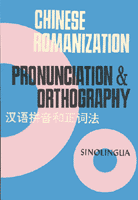Chinese Romanization: Pronunciation and Orthography
Yin Binyong and Mary Felley
Beijing: Sinolingua, 1990.
Search bookstores for this title.
"This book is an indispensible tool for understanding the officially approved rules of
Pinyin orthography." -- John DeFrancis
Contents

-
Pronunciation
- The Alphabet
-
Simple Vowels and Tones
- Simple Vowels
- Tones and Tone Markers
- Writing i, u and ü as Individual Syllables
-
The Consonants b, p, m, and f
- Pronunciation
- Spelling and Words
- The Neutral Tone
-
Double Vowels: ai, ei, ao, and ou
- Pronunciation
- Placement of the Tone Marker
- Spelling and Words
-
The Consonants d, t, n, and l
- Pronunciation
- Spelling and Words
- Tone Modification in Reading
-
Vowels in Combination With Nasal Consonants: an, en, ang, eng and ong
- pronunciation
- Spelling and Words
- Syllable Separation and the Apostrophe
-
The Consonants g, k, and h
- Pronunciation
- Spelling and Words
- Tone Modification in Reading (continued)
-
Vowel Constructions with u: ua, uo, uai, uei, uan, uen, uang and ueng
- Pronunciation
- Spelling and Words
- The u-Constructions as Independent Syllables
-
The Consonants z, c, and s
- Pronunciation
- Spelling and Words
- z, c, s and Their Apical Vowel
-
The Consonants zh, ch, sh, and r
- Pronunciation
- Spelling and Words
- zh, ch, sh, r and Their Apical Vowel
-
Vowel Constructions with i: ia, ie, iao, iou, ian, iang, in, ing, and iong
- Pronunciation
- Spelling and Words
- The i-Constructions as Independent Syllables
-
The Consonants j, q and x
- Pronunciation
- Spelling and Words
- r-Suffixed Syllables
-
Vowel Constructions with ü: üe,
üan and ün
- Pronunciation
- Spelling and words
- The ü-Constructions as Independent Syllables
-
Initials, Finals, and Table of Syllables
- Initials
- Finals
- Table of Syllables
-
Orthography
-
Common Nouns
- Introduction
- Simple Nouns
- Nouns with Prefixes
- Nouns with Suffixes
- Reduplicated Nouns
- Nouns of Modifier-Modified Construction sample section
- Nouns of Coordinate Construction
- Nouns of Verb-Object and Subject-Predicate Construction
- Locational Nouns
- Nouns of Time
- Noun Phrases that Express a Single Concept
-
Proper Nouns
- Introduction
- Place Names
- Personal Names sample section
- Transliteration of Foreign Place Names and Personal Names sample section
- Other Proper Nouns
- Proper Nouns in Combination with Common Nouns
-
Pronouns
- Personal Pronouns
- Demonstrative Pronouns
- Interrogative Pronouns
-
Numerals and Measure Words Numerals
- Whole Numbers
- Ordinals, Fractions, Decimals and Multiples
- Approximate Numerals
- Written Forms of the Numeral yi Measure Words
- Noun Measure Words
- Verb Measure Words
-
Verbs
- Categories of Verbs
- Tenses
- Verb Reduplication
- Verb-Object Constructions
- Verb-Complement Constructions sample section
- Modal Verb
- Directional Verbs
- The Verb shi
- The Verb you
-
Adjectives
- Introduction
- Simple Adjectives
- Adjectives Formed Through Affixation
- Reduplicated Adjectives
- Coordinate-Compound Adjectives
- Modifier-Modified Adjectives
-
Adverbs
- Categories of Adverbs
- Adverb Structure
- Adverbs of Negation
- Other Common Adverbs
-
Prepositions and Conjunctions
-
Prepositions
- Categories and Structure
- Usage and Written Forms
-
Conjunctions
- Categories and Structure
- Usage and Written Forms
-
Prepositions
- Particles, Interjections and Onomatopoeic Words
-
Idioms and Classical Elements
- Four-Syllable Idioms
- Adages, Proverbs and Xiehouyu
- Classical Elements in Modern Chinese
-
Sentences and Punctuation
- Sentence Components
- Categories of Sentences
- Punctuation Marks
- Use of the Hyphen; Abbreviation and Short Forms sample section
-
Hanyu Pinyin in Application
- Prose
- Poetry
- Fiction
- Essay
- Science Writing
-
Common Nouns
- Index
- Bibliography
